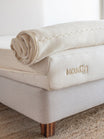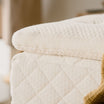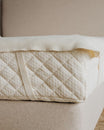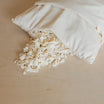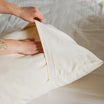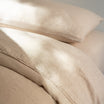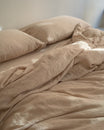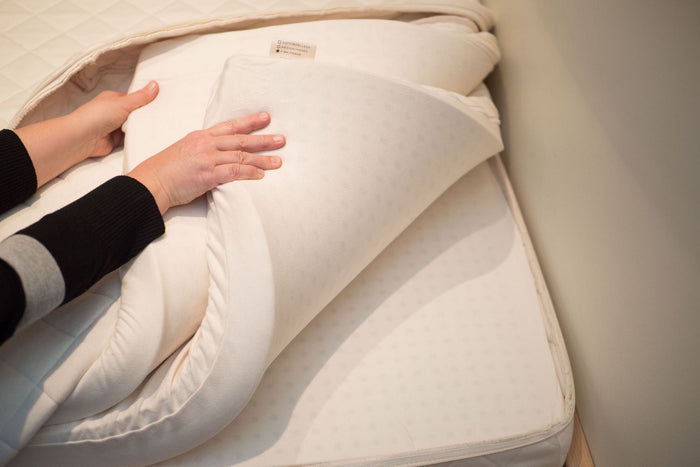If you’ve spent any time online lately, you’re almost certain to have been bombarded with ads for memory foam mattresses. From websites to social media to podcasts, companies like Casper and Endy have mounted concerted campaigns to disrupt the old system that required consumers to physically visit a mattress store, lie down on a bunch of different mattresses, and make a decision on the spot.
And while we love that it’s now possible to buy a mattress online, does anyone really know what they’re getting when the box shows up on the front porch? What is your new mattress made of? What do the terms and certifications mean? Is it going to help you sleep better? For us, the big question is: how does a memory foam mattress compare to a premium organic latex rubber mattress like the ones we stock at the Resthouse website?
Well, tuck yourselves in because we went under the covers to do the research you’ve been dreaming of. Let’s talk about how organic latex stands head, shoulders, spine, and hips above the competition.
Materials
Your skin is the largest organ in your body. So it’s important that the materials you spend so much time in contact with (eight hours a night if you’re lucky) are natural and beneficial to your health, as well as friendly to the environment.
Unlike petroleum-based memory foam beds, a high-quality organic latex mattress is made from 95% pure rubber that is produced naturally by rubber trees and harvested sustainably. Plus, the mattresses that we love at Resthouse are wrapped in 100% organic cotton fabric and wool batting, two healthful materials that offer significantly reduced environmental impact over synthetic alternatives. These types of mattresses also choose to keep the various support layers in place using a tight-fitting cover, rather than the glues and adhesives of unknown origin that may be found in conjunction with memory foam.
Some memory foam manufacturers have sought to overcome the stigma of petroleum-based foams by labelling their beds as “plant-based.” A deeper look reveals that the materials in these mattresses may only include up to 30% soy derivatives. This is absolutely a step in the right direction but could hardly be considered plant-based.
Characteristics
Both latex and memory foam mattresses offer different feel and support compared to traditional coil mattresses. Choose either one and the days of jumping on the bed are over, since these newer materials do a much better job of absorbing impact and motion transfer between sleepers than old-style beds filled with springs. However, organic latex beds tend to do a much better job of reducing wiggles from your slumbering partner compared to beds with layers of inexpensive polyurethane foam. Those same polyurethane layers are also responsible for the lack of durability in memory foam beds, which can end up with dents or divots after a short period of time, unlike latex mattresses, which retain their shape and resilience much longer.
The durability factor also means that memory foam beds could need to be replaced more frequently than you might expect. With the low prices of some brands, this may not be a huge factor. However, when considering your options, keep in mind that latex does not off-gas—that is, it doesn’t release chemical compounds into the air once you take it out of the package. Memory foam does, it does it for a considerable portion of its life, and the off-gassing is renewed each time you have to buy a new one.
Thanks to its composition and structure, natural latex rubber is both breathable and temperature neutral, so regardless of whether you sleep hot or cold, your bed works with your needs, and you get a better sleep. Conversely, memory foam is heat activated, so if you sleep in a cool room, expect to be jumping into a hard and cold bed, then waking up sweaty a few hours later.
The structure of latex also gives it the perfect level of support and rebound, meaning that when you roll over, you don’t have to wait for the bed to slowly re-mould under you to get comfortable. Plus the variable density of latex means that you can choose the level of support that works best for your body, ensuring ideal alignment of your shoulders, spine, hips, and knees; memory foam that happens to be too thick for your body type could end up leading to spinal misalignment.
Certification
The mattresses that we bring to the Resthouse community fall under two main certifications: Global Organic Latex Standard (GOLS) and Global Organic Textile Standard (GOTS). These are internationally-recognized certifications administered by impartial third parties that guarantee that the materials and production methods are ecologically and socially responsible. This means that the latex core as well as the surrounding materials like fabric and batting are just as healthful and ethical as we claim they are. Many memory foam mattresses come emblazoned with CertiPUR certification, which is an industry organization run by the Alliance for Flexible Polyurethane Foam, whose goal is to sell as much polyurethane foam as possible, regardless of whether these mattresses are beneficial to the sleeper or the environment. So while GOLS and GOTS are impartial, science-based certifications that benefit the consumer, CertiPUR is not.
Now, some might call our environmentally-friendly beds “green.” But a quick web search will reveal that there are all kinds of “green” beds out there; so many, in fact, that the term has pretty much lost all meaning. So we don’t use that term. Ultimately, when deciding on a mattress, choose one with reliable certifications from recognized institutions, rather than fancy marketing.
And at the end...
There are plenty of highly durable mattresses out there that will last for years of comforting, restful sleep. But the reality is that all good things come to an end. So when your mattress has cradled your slumbering body for the last time, what’s going to happen to it?
If it’s made from organic latex rubber, which is biodegradable, your mattress will eventually return to the earth that produced its materials in the first place. That memory foam bed? Well, it’s essentially a big rectangle made of plastic, so you can expect it to stick around long after we’ve all gone for our last, long nap. The choice is yours.



